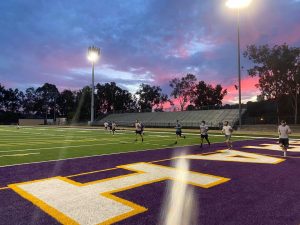Con: Practicing online is enough
November 12, 2020
After months of delay, the implementation of rules for in-person learning have finally begun. Los Angeles County Department of Public Health has approved a staged approach for schools in the area to open their doors for a limited subset of students. This process has already begun for many schools in the county, with Diamond Bar High School joining them.
The current plan permits athletes and performing arts students to return to campus for rehearsals and practice. However, the change is hardly necessary, if not useless all around.
For sports and performing arts, practice now involves individuals gathering in sizable groups of upwards of 12 people, which in itself already presents a high possibility of spreading the virus. Having to wear masks during practice would simply present yet another obstacle for the students.
Even the sports that one may not expect to have trouble with distance guidelines will face barriers in one way or another. For instance, during cross country practice, runners are close to one another as they pass each other on the track. COVID-19 safety measures recommend every person to stay at least six feet apart from any other individual, making practice near impossible, and this change, useless.
Sports such as football and wrestling involve athletes to make physical contact with one another. And if they were to focus on aspects of training that don’t require contact, then they could have simply trained at home, which is much safer. Seeing as students will not even be allowed to be within an arm’s length of one other, there’s no advantage to having on-campus practice.
Performing arts ensembles like orchestra and band will require students to wear masks–it’s unclear whether they’d be allowed to take these off while playing–and put preventive material on their instruments. This material goes over the end of an instrument, where air flows out, to keep the player’s breath from spreading significantly. However, at the same time, it also alters the sound of the instrument so that it is comparably poor to the quality in Zoom calls.
Not to mention that in order to keep socially distanced, the amount of students that can attend on-campus practice at a time will be significantly less than that of virtual rehearsals. Although the sound quality will be marginally better, this method of rehearsing will slow down the learning process quite a bit compared to Zoom meeting practices. With such drawbacks as these, it seems that there’s no significant advantage to practicing on campus compared to online rehearsals.
For some students, the option to return to campus may even mean putting their health at risk for fear of losing out on advantageous opportunities. Student leaders who don’t feel safe returning to campus for practice may be at risk of losing their position to someone who is willing to attend.
Even with a risk like contracting the deadly virus that has taken over the world in the past year, there is no guarantee that everyone will keep their masks on, stay six feet apart, and follow other safety precautions set in place all the time. This guarantee is even more nonexistent when it comes to high school students, most of which haven’t seen their fellow classmates in person for a better part of the year.
Thus, this major academic change will only result in more setbacks for both organizations and students alike. Most students have already adjusted themselves to learning at home to some extent. For these groups to return to campus is not only costly and ineffective, but will also cause more problems for students in the long run.




